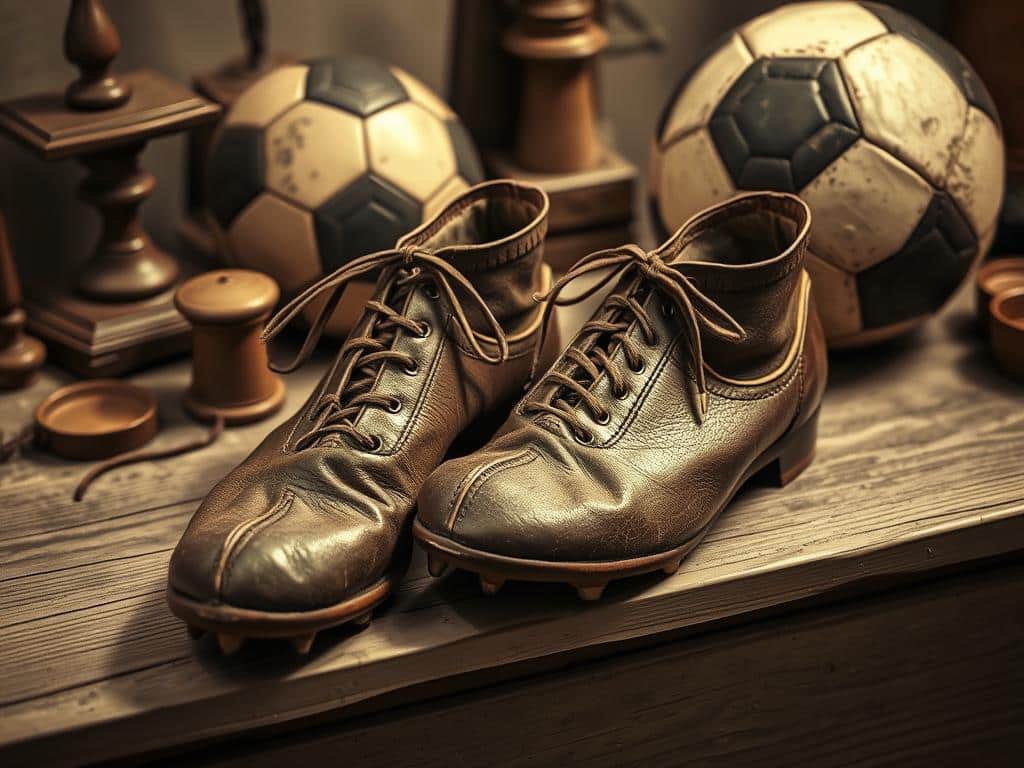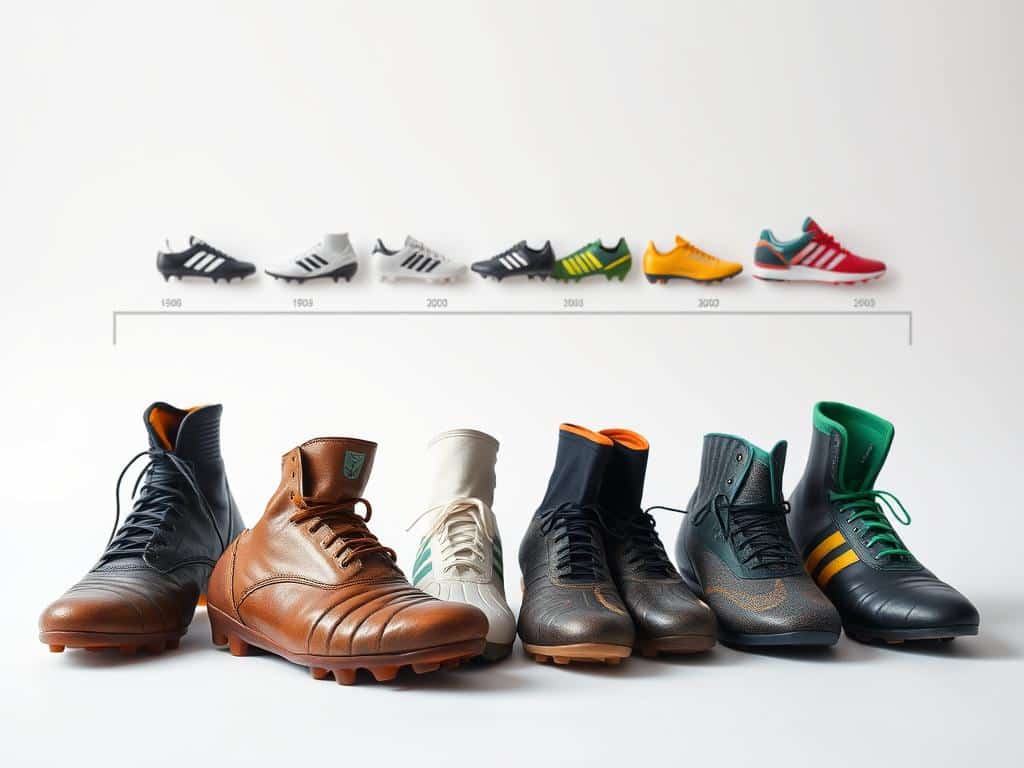Did you know the first pair of soccer cleats dates back to King Henry VIII’s wardrobe in 1526? These early boots were heavy and made for protection, not performance. Imagine kicking a ball in footwear that weighed over 500 grams!
Over centuries, soccer footwear has transformed dramatically. From bulky leather designs to lightweight, high-tech boots, the evolution has been incredible. Modern football boots focus on speed, control, and comfort, making the game faster and more exciting.
Soccer’s global popularity has driven innovation in shoe design. Brands like Adidas and Nike have created iconic boots that changed the game. Whether you’re a player or a fan, understanding this journey adds a new layer of appreciation for the sport.
Ready to dive deeper? Let’s explore how soccer footwear has shaped the game we love today.
Early Beginnings and the Birth of Soccer Footwear
The story of soccer footwear begins in the Tudor era with a royal twist. In 1525, King Henry VIII’s personal shoemaker, Cornelius Johnson, crafted the very first pair of cleats. These boots were designed for the king’s love of the game, marking a pivotal moment in time.
These early cleats were far from what we see today. Made from heavy leather, they resembled work boots more than sportswear. The focus was on durability, using the best materials available at the time. Each boot weighed over 500 grams, making them sturdy but cumbersome for players.
This design laid the foundation for future innovations. The transition from generic work boots to footwear specifically designed for sport was groundbreaking. It highlighted the emerging brand of royal craftsmanship and set the stage for centuries of evolution.
By 1525, soccer footwear had its first official year in the spotlight. King Henry VIII’s cleats were not just footwear; they were a symbol of the game’s growing importance. This regal origin story adds a fascinating layer to the sport we love today.
Emergence of Cleats During the 1800s
The 1800s marked a turning point in the evolution of soccer footwear. As the game grew in popularity, players needed better tools to handle rough, uneven pitches. This led to the birth of modern cleats, designed to improve grip and stability.

In the early days, soccer was a rough and unstructured sport. Players often wore heavy work boots, which offered little support or traction. To solve this, they manually hammered metal tacks or studs onto the sole of their shoes. This simple yet effective innovation transformed the game.
With the introduction of the Laws of the Game in the late 1800s, soccer became more organized. This shift demanded specialized footwear. Cleats were no longer just modified work boots; they were designed specifically for the sport. The focus shifted to improving grip, comfort, and performance.
Here are some key developments during this period:
- Metal studs were added to the sole for better traction on muddy fields.
- The design transitioned from bulky work boots to lighter, more agile shoes.
- Improved grip and foot stability became top priorities.
By the end of the 1800s, soccer cleats had taken a significant leap forward. They were no longer just footwear; they were essential tools for the game. This era laid the foundation for the high-tech boots we see today.
History of Soccer Shoes: Technological Advances and Design Shifts
The 20th century brought groundbreaking changes to the world of football footwear. Innovations in technology transformed boots from heavy, cumbersome designs to lightweight, high-performance gear. This era marked a shift from traditional materials to advanced synthetics, revolutionizing the game.
Transition from Heavy Leather to Lightweight Materials
Early boots were made from thick leather, prioritizing durability over comfort. By the mid-1900s, brands began experimenting with lighter materials like rubber and plastic. These changes reduced weight and improved agility, allowing players to move faster and with greater precision.
The introduction of synthetic materials like nylon and polyester further enhanced performance. These materials offered better flexibility and durability, making them ideal for modern football. The shift from natural to synthetic materials was a game-changer, paving the way for today’s high-tech boots.
Introduction of Replaceable Studs and Enhanced Grip
Another major innovation was the development of replaceable studs. Early cleats had fixed metal studs, which limited adaptability. The introduction of interchangeable studs allowed players to customize their footwear based on field conditions.
Here’s how this technology improved the game:
- Players could switch between long and short studs for wet or dry fields.
- Enhanced grip reduced slips and injuries, improving overall protection.
- Flexible soles made from rubber and plastic provided better traction and comfort.
These advancements not only boosted performance but also extended the lifespan of football boots. Players could now adapt their footwear to different conditions, giving them a competitive edge.
The impact of these technological shifts is undeniable. From heavy leather boots to lightweight synthetics, the evolution of football footwear has been driven by a commitment to innovation. These changes have made the game faster, safer, and more exciting for players and fans alike.
Changing Styles and Cultural Impact in the 1960s and 1970s
The 1960s and 1970s revolutionized the way players approached the game, starting with their footwear. This decade saw a dramatic shift from bulky, ankle-high boots to sleek, lower-cut designs. These changes weren’t just about style; they transformed performance on the pitch.
Lower Cut Designs and Boost in Performance
The move to lower-cut boots was a game-changer. Players gained greater agility and flexibility, allowing them to move faster and with more precision. This style also reduced weight, making it easier to control the ball and react quickly during play.
Manufacturers like Puma and Adidas led the charge, experimenting with lighter materials and innovative designs. These advancements turned football boots into high-performance tools, giving players an edge on the pitch.
Rise of Iconic Brands and Player Endorsements
The 1960s and 1970s also marked the rise of player endorsements. Legends like Pele became the face of brands, boosting their popularity worldwide. These partnerships not only promoted the footwear but also influenced its design and functionality.
Iconic brands like Puma and Adidas became household names, setting trends that continue to shape the game today. Their focus on innovation and performance during this decade cemented their legacy in the world of football.
The Digital Era: Enhanced Performance and Personalized Innovation
The digital age has brought unprecedented innovation to the world of sport footwear. Today’s soccer boots are more than just gear; they’re high-tech tools designed to elevate performance. From laser technology to smart features, the latest advancements are redefining the game.
Laser Technology and Smart Features in Modern Boots
Laser technology has revolutionized how boots are made. It ensures precision in fitting, giving players a perfect match for their feet. This innovation enhances comfort and reduces the risk of injuries during a match.
Smart features are another game-changer. Many boots now include sensors that track performance metrics like speed, distance, and even heart rate. This data helps players analyze their game and make improvements. It’s like having a coach on your feet!
Customization Trends and Footwear Personalization
Personalization is a big trend in today’s soccer boots. Players can now customize their footwear with names, numbers, and even unique designs. This not only boosts confidence but also creates a stronger connection between the player and their gear.
Research-driven design has also played a key role. Brands use advanced materials and production techniques to create boots that are lighter, stronger, and more flexible. These improvements enhance on-field performance and ensure durability.
Here’s how modern innovations are shaping the game:
- Laser technology ensures precise fitting and comfort.
- Smart features track performance metrics in real-time.
- Customization options allow players to express their style.
- Research-driven designs improve both comfort and performance.
This period of innovation is transforming soccer boots into essential tools for success. With every match, players are experiencing the benefits of these advancements. The future of sport footwear is here, and it’s more exciting than ever.
Iconic Brands and Footwear Pioneers in Soccer History
The rivalry between Adidas and Puma began with a family split, shaping the future of football footwear. After World War II, the Dassler brothers went their separate ways, creating two of the most influential brands in the game. This split sparked innovation, leading to a variety of designs that revolutionized how players performed on the pitch.
![]()
Adidas, Puma, Nike, and the Birth of the Predator
Adidas and Puma quickly became pioneers, each with a unique focus on performance and style. Adidas introduced the Predator in the 1990s, a boot that changed the game with its rubber fins for better ball control. This design became iconic, influencing generations of players.
Nike entered the scene later but made a significant impact with models like the Mercurial. Known for their lightweight construction and sleek design, these boots set new standards for speed and agility. The variety of options available today can be traced back to these groundbreaking innovations.
Legacy Designs and Their Impact on Today’s Game
Legacy designs like the Predator continue to inspire modern boots. Adidas reintroduced the Predator in 2018, blending classic elements with advanced materials like Primeknit. This fusion of old and new highlights the enduring influence of these iconic models.
Here’s how these designs have shaped the game:
- Improved toe control and ball handling.
- Enhanced durability with materials like steel and rubber.
- A focus on lightweight construction for better performance.
These innovations have set the benchmark for quality and performance, ensuring that players at all levels can benefit from decades of research and development.
From the work of the Dassler brothers to the latest high-tech boots, the evolution of football footwear is a testament to the power of creativity and innovation. This journey continues to inspire players and fans alike, making the game more exciting than ever.
Final Reflections on a Timeless Journey of Soccer Shoes
From heavy work boots to cutting-edge cleats, the journey of soccer footwear is a testament to innovation. Over centuries, designs have evolved from bulky leather to lightweight, high-tech gear. Each pair reflects a milestone in performance and style.
Early boots prioritized durability, often featuring screw-in studs for better grip. Today, advancements like laser technology and smart features have transformed the game. These innovations ensure players adapt to any condition, enhancing both safety and agility.
Periods of war and peace have shaped this evolution, driving creativity and progress. Modern designs honor this legacy while pushing boundaries. The future promises even more breakthroughs, keeping the sport dynamic and exciting.
Every boot tells a story of passion and progress. As we look ahead, the journey continues, inspiring players and fans alike. The evolution of soccer footwear is far from over, and the best is yet to come.







